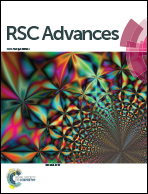Theoretical prediction of detonation performance and stability for energetic polydinitroaminoprismanes
Abstract
Density functional theory simulations were performed to calculate the heats of formation in the gas state [HOF(g)] and in the solid state [HOF(s)], detonation performance and stability of twelve polydinitroaminoprismanes. Our results show that C2 has the best detonation properties of all the molecules, the detonation velocity is 9.56 km s−1 and the detonation pressure is 41.88 GPa, and detonation properties of C2, C3, D1, D2, and D3 are better than those of 1,3,5,7-tetranitro-1,3,5,7-tetraazacyclooctane (HMX). The stability of all the molecules was investigated by analyzing the energy gaps, bond dissociation energies, and characteristic heights of the molecules. The results show that the N–NO2 bonds of all the molecules are trigger bonds during the thermolysis initiation process, and seven molecules (A, B1–B3 and C1–C3) are less sensitive than 2,4,6,8,10,12-hexanitro-2,4,6,8,10,12-hexaazatetracyclo[5.5.0.0.0]dodecane (CL-20). The results of this study may provide basic information for the further study of this kind of compounds and molecular design of novel energetic materials.


 Please wait while we load your content...
Please wait while we load your content...